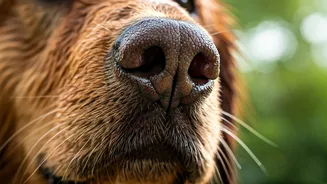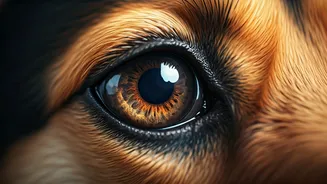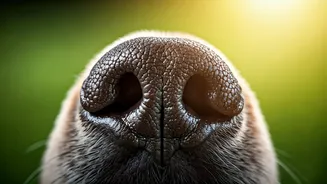Hearing: Super Sonic
Dogs possess exceptionally sensitive hearing, significantly surpassing human capabilities. Their ears are designed to capture a broader range of frequencies,
including those inaudible to us. The position and flexibility of their ears also play a crucial role, allowing them to pinpoint the source of sounds with remarkable accuracy. They can rotate their ears to pick up subtle noises. This adaptability allows them to hear sounds from up to four times the distance humans can. This superior auditory acuity enables them to perceive faint sounds and distinguishes dogs' ability to react to commands or sounds that humans might miss entirely.
Smell: A World of Scents
A dog's sense of smell is arguably its most impressive sensory feat. Their olfactory abilities are thousands to millions of times more sensitive than ours. This is due to several factors, including a larger nasal cavity and a significantly higher number of olfactory receptor cells. Dogs also have a specialized organ called the vomeronasal organ, which helps them detect pheromones and other scent-related chemicals. They can discriminate between different odors, even those that humans cannot detect. It’s worth noting that the combination of these factors allows dogs to be employed in various tasks, from search and rescue to detecting diseases.
Vision: Beyond the Spectrum
Dogs do not see the world in black and white. However, their vision differs significantly from humans in other ways. They have a dichromatic vision, seeing primarily in shades of blue and yellow, with a limited ability to perceive red and green. This doesn’t mean they're colorblind. They perceive the world with distinct shades of blues, yellows, and grays. Their visual field is wider than ours, providing a greater peripheral view, but their visual acuity is less sharp, making it challenging for them to see details at a distance. Moreover, their ability to detect movement is more refined than ours.
Taste: Less is More?
The sense of taste in dogs is not as developed as their sense of smell. They possess fewer taste buds than humans. While dogs can distinguish between sweet, sour, bitter, and salty tastes, their sensitivity is not as refined. Interestingly, they have a preference for the taste of meat and fat, which is likely an evolutionary adaptation to their carnivorous diet. They are less sensitive to sweets than humans. Their primary focus in food selection is often driven by smell and texture rather than taste. This explains why dogs eat a wide variety of things.
Touch: Sensory Exploration
Touch plays a crucial role in a dog's interaction with the world. They have specialized sensory receptors located throughout their body, including the skin, nose, and paws. These receptors provide information about pressure, temperature, and pain. They also use their whiskers as sensory tools to navigate their environment, especially in low-light situations. Dogs derive comfort and social bonding through touch. This makes them receptive to petting, grooming, and other forms of physical contact. The presence of touch receptors in their bodies facilitates their ability to understand and engage with the world.
Proprioception: Body Awareness
Proprioception is the sense of body position and movement, allowing dogs to be aware of their limbs and body in space. This internal awareness helps them to navigate obstacles, maintain balance, and coordinate movements. Special receptors in muscles, tendons, and joints provide information about the position and movement of their bodies. This allows dogs to perform complex physical activities such as running, jumping, and agility exercises. It's also crucial for their overall coordination and spatial awareness. The dogs’ reliance on this sense enables them to perform a variety of behaviors.










